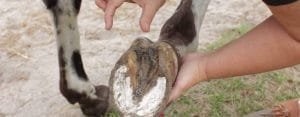Laminitis is a serious condition that affects horses’ hooves.
It can cause pain and discomfort, so it’s important for horse owners to understand what it is, how to spot it, and how to prevent it. Let’s dive into the details!
What is Laminitis?
Laminitis occurs when the laminae, the tissue that connects the hoof wall to the bone inside the hoof, become inflamed. This inflammation can cause severe pain and may even lead to the rotation or sinking of the bone. Horses suffering from laminitis may have difficulty walking and may show signs of distress.
Causes of Laminitis
There are several factors that can lead to laminitis. Here are some of the most common causes:
Dietary Changes: Sudden changes in diet, especially an increase in rich feeds (like grain or lush grass), can trigger laminitis. Too much sugar and starch can overload the digestive system.
Obesity: Overweight horses are at higher risk. Excess weight can put extra stress on their hooves.
Endocrine Disorders: Conditions like Cushing’s disease or insulin resistance can increase the risk of laminitis. These disorders affect how the body manages sugars and hormones.
Exercise: Lack of exercise can contribute to laminitis. Horses that are kept in stalls for long periods may develop this condition more easily.
Injury or Illness: Laminitis can occur after a horse has been injured or has been ill. Inflammation in the body can sometimes affect the hooves.
Symptoms of Laminitis

Recognizing the signs of laminitis early can help prevent serious damage. Here are some common symptoms to look out for:
Lameness: Your horse may show signs of lameness, especially when moving. They might seem reluctant to walk or run.
Abnormal Posture: Horses with laminitis often shift their weight to their back legs to relieve pressure on their front feet. You may notice them standing with their front legs stretched out in front.
Heat in the Hooves: The hooves may feel warm to the touch. This can be a sign of inflammation.
Rapid Heart Rate: Some horses may have a faster heartbeat when suffering from laminitis.
Frog Pulses: You might feel strong pulses in the hooves, particularly in the area of the frog.
Prevention of Laminitis

Preventing laminitis is much easier than treating it. Here are some practical tips to keep your horse safe:
Monitor Diet: Be careful with your horse’s diet. Avoid sudden changes and limit access to rich pasture grass. Providing a balanced diet with appropriate amounts of hay and grains is essential.
Weight Management: Keep your horse at a healthy weight. Regularly assess their body condition and adjust their diet and exercise as needed.
Regular Exercise: Ensure your horse gets enough exercise to maintain their health. Daily turnout or riding can help keep them fit.
Regular Veterinary Care: Schedule regular check-ups with your veterinarian. They can help identify any risk factors for laminitis and monitor conditions like Cushing’s disease.
Proper Hoof Care: Regular hoof care, including trimming and shoeing, is essential. A qualified farrier can help ensure that your horse’s hooves are healthy and well-maintained.
Stay Informed: Learn about laminitis and stay updated on new research and treatments. Being informed can help you take better care of your horse.
Laminitis is a serious condition, but with the right knowledge and care, you can help prevent it. Keep an eye on your horse’s diet, weight, and overall health. If you notice any symptoms of laminitis, contact your veterinarian immediately. With your attention and care, your horse can lead a happy, healthy life!




